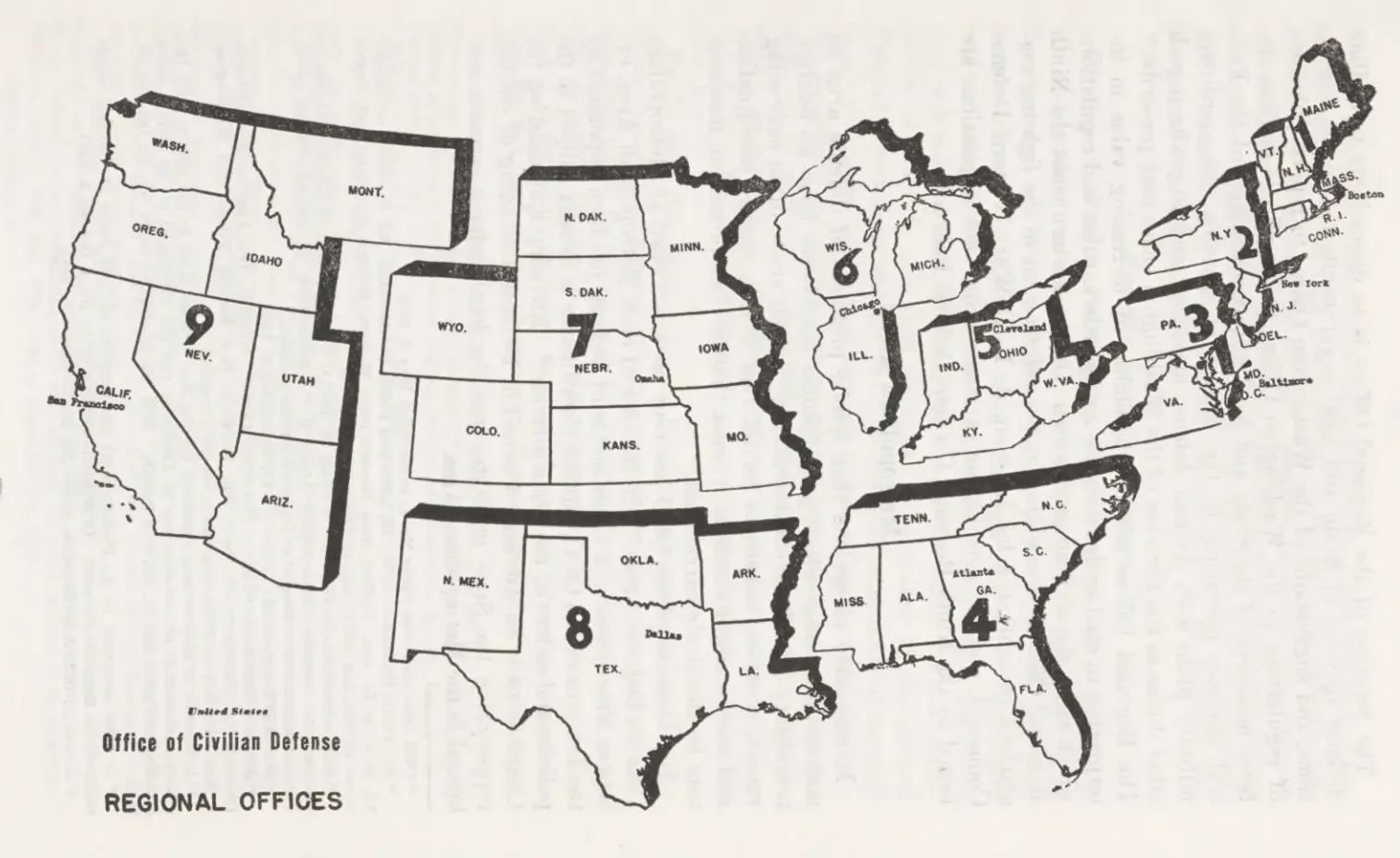Office of Civilian Defense Regional Offices
The Office of Civilian Defense (OCD) established nine Regional Civilian Defense Areas on July 10, 1941 (later called Civilian Defense Regions from May 1942).
Each area contained a Regional Office, managed by a Regional Director, appointed by the Director of the OCD with the President's approval.
The Regional Office disseminated communications from the Washington Office; reported regulation violations in their jurisdictions to the Washington Office; coordinated civilian defense measures of the State and local governments and the Federal agencies operating in the region; and coordinated military plans with civilian defense measures.
The Office of Civilian Defense (OCD) established nine Regional Civilian Defense Areas on July 10, 1941 (later called Civilian Defense Regions from May 1942).
Each area contained a Regional Office, managed by a Regional Director, appointed by the Director of the OCD with the President's approval.
The Regional Office disseminated communications from the Washington Office; reported regulation violations in their jurisdictions to the Washington Office; coordinated civilian defense measures of the State and local governments and the Federal agencies operating in the region; and coordinated military plans with civilian defense measures.
Advising and assisting the Regional Directors, were the Regional Civilian Defense Boards. These Boards were composed of the Regional Director as chairman, and a representative of each of the following Federal departments and agencies:
U. S. Army, representing the Commanding General, Service Command, Services of Supply;
U. S. Army, representing the Air Force Commander charged with the air defense of the area;
U. S. Navy, representing the Naval District Commandant;
Department of Justice (FBI Division);
Federal Security Agency;
Council of State Governments;
American Municipal Association;
United States Conference of Mayors; and
American Red Cross.
The states within each region were the same as those covered by the War Department Service Commands, Services of Supply areas. The War Department Services of Supply (SOS) was established in 1942, a wartime reorganization created as the logistical backbone of the U.S. Army, alongside the Army Ground Forces (AGF) and the U.S. Army Air Forces (USAAF). It was later renamed the Army Service Forces (ASF) in 1943.
The states within each Army Corps Area are listed below:
Region 1 – Boston, Massachusetts. (covering New England). First Corps Area within First Army Area - ME, VT, NH, MA, CT, RI
Region 2 – New York, New York. Second Corps Area within First Army Area - NY, NJ, DE
Region 3 – Baltimore, Maryland. Third Corps Area within First Army Area - PA, MD, VA, DC
Region 4 – Atlanta, Georgia. Fourth Corps Area within Second Army Area - NC, SC, GA, FL, AL, MS, TN
Region 5 – Cleveland, Ohio (moved from Columbus). Fifth Corps Area within Second Army Area - OH, IN, KY, WV
Region 6 – Chicago, Illinois. Sixth Corps Area within Second Army Area - IL, MI, WI
Region 7 – Omaha, Nebraska. Seventh Corps Area within Third Army Area - MO, KS, NE, CO, IA, MN, ND, SD, WY
Region 8 – Dallas, Texas (moved from San Antonia). Eighth Corps Area within Third Army Area - AR, LA, TX, OK, NM
Region 9 – San Francisco, California. Ninth Corps Area within Third Army Area - WA, OR, CA, ID, MT, NV, UT, AZ, AK
Whereas just one West Coast regional office - San Francisco - covered all of Arizona, California, Idaho, Montana, Nevada, Oregon, Utah and Washington, the East Coast had four regional offices Boston (covering New England), New York covering New York and New Jersey’s ports, Baltimore covering the central zone (including the important naval bases in Virginia) and Atlanta covering the south-eastern states. Dallas (which replaced San Antonio) covered Texas and the surrounding states. Chicago, Cleveland and Omaha covered the Midwestern states.
By 1944, the risk of an attack on the US mainland was deemed highly unlikely. Consequently, the OCD Regional Offices were abolished by OCD Administrative Order No. 38, June 7, 1944, effective July 1, 1944. Four small field offices in New York, Chicago, New Orleans and San Francisco dealt with any remaining OCD issues.
Executive Order 9562 of June 4, 1945, closed the OCD, effective June 30, 1945.

